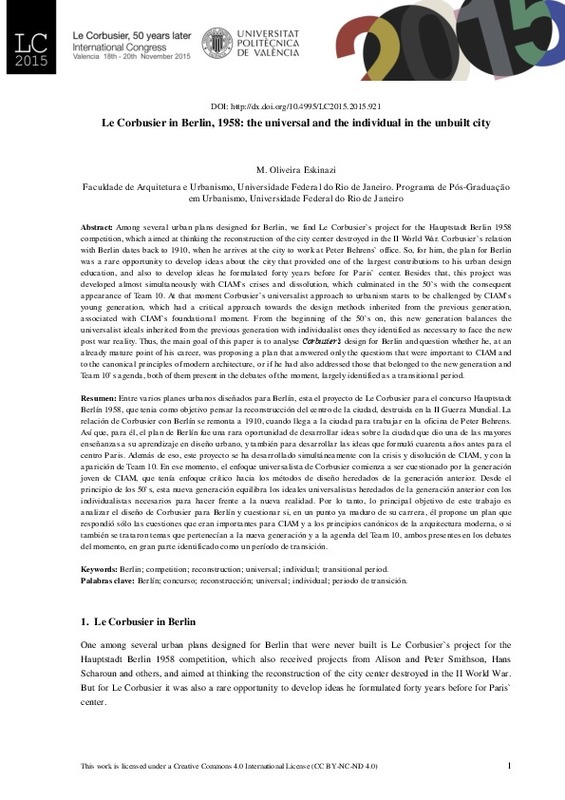JavaScript is disabled for your browser. Some features of this site may not work without it.
Buscar en RiuNet
Listar
Mi cuenta
Estadísticas
Ayuda RiuNet
Admin. UPV
Le Corbusier in Berlin, 1958: the universal and the individual in the unbuilt city
Mostrar el registro sencillo del ítem
Ficheros en el ítem
| dc.contributor.author | Oliveira Eskinazi, Mara
|
es_ES |
| dc.date.accessioned | 2017-09-18T10:56:05Z | |
| dc.date.available | 2017-09-18T10:56:05Z | |
| dc.date.issued | 2016-03-03 | |
| dc.identifier.isbn | 9788490483732 | |
| dc.identifier.uri | http://hdl.handle.net/10251/87427 | |
| dc.description.abstract | [EN] Among several urban plans designed for Berlin, we find Le Corbusier`s project for the Hauptstadt Berlin 1958 competition, which aimed at thinking the reconstruction of the city center destroyed in the II World War. Corbusier`s relation with Berlin dates back to 1910, when he arrives at the city to work at Peter Behrens` office. So, for him, the plan for Berlin was a rare opportunity to develop ideas about the city that provided one of the largest contributions to his urban design education, and also to develop ideas he formulated forty years before for Paris` center. Besides that, this project was developed almost simultaneously with CIAM`s crises and dissolution, which culminated in the 50`s with the consequent appearance of Team 10. At that moment Corbusier`s universalist approach to urbanism starts to be challenged by CIAM`s young generation, which had a critical approach towards the design methods inherited from the previous generation, associated with CIAM`s foundational moment. From the beginning of the 50`s on, this new generation balances the universalist ideals inherited from the previous generation with individualist ones they identified as necessary to face the new post war reality. Thus, the main goal of this paper is to analyse Corbusier’s design for Berlin and question whether he, at an already mature point of his career, was proposing a plan that answered only the questions that were important to CIAM and to the canonical principles of modern architecture, or if he had also addressed those that belonged to the new generation and Team 10`s agenda, both of them present in the debates of the moment, largely identified as a transitional period. | es_ES |
| dc.description.abstract | [ES] Entre varios planes urbanos diseñados para Berlín, esta el proyecto de Le Corbusier para el concurso Hauptstadt Berlín 1958, que tenia como objetivo pensar la reconstrucción del centro de la ciudad, destruida en la II Guerra Mundial. La relación de Corbusier con Berlín se remonta a 1910, cuando llega a la ciudad para trabajar en la oficina de Peter Behrens. Así que, para él, el plan de Berlín fue una rara oportunidad de desarrollar ideas sobre la ciudad que dio una de las mayores enseñanzas a su aprendizaje en diseño urbano, y también para desarrollar las ideas que formuló cuarenta años antes para el centro Paris. Además de eso, este proyecto se ha desarrollado simultáneamente con la crisis y disolución de CIAM, y con la aparición de Team 10. En ese momento, el enfoque universalista de Corbusier comienza a ser cuestionado por la generación joven de CIAM, que tenía enfoque crítico hacia los métodos de diseño heredados de la generación anterior. Desde el principio de los 50`s, esta nueva generación equilibra los ideales universalistas heredados de la generación anterior con los individualistas necesarios para hacer frente a la nueva realidad. Por lo tanto, lo principal objetivo de este trabajo es analizar el diseño de Corbusier para Berlín y cuestionar si, en un punto ya maduro de su carrera, él propone un plan que respondió sólo las cuestiones que eran importantes para CIAM y a los principios canónicos de la arquitectura moderna, o si también se trataron temas que pertenecían a la nueva generación y a la agenda del Team 10, ambos presentes en los debates del momento, en gran parte identificado como un período de transición. | es_ES |
| dc.format.extent | 17 | es_ES |
| dc.language | Inglés | es_ES |
| dc.publisher | Editorial Universitat Politècnica de València | es_ES |
| dc.relation.ispartof | LE CORBUSIER. 50 AÑOS DESPUÉS | es_ES |
| dc.rights | Reconocimiento - No comercial - Sin obra derivada (by-nc-nd) | es_ES |
| dc.subject | architecture | es_ES |
| dc.subject | le corbusier | es_ES |
| dc.subject | modern movement | es_ES |
| dc.title | Le Corbusier in Berlin, 1958: the universal and the individual in the unbuilt city | es_ES |
| dc.type | Capítulo de libro | es_ES |
| dc.type | Comunicación en congreso | es_ES |
| dc.identifier.doi | 10.4995/LC2015.2015.921 | |
| dc.rights.accessRights | Abierto | es_ES |
| dc.description.bibliographicCitation | Oliveira Eskinazi, M. (2016). Le Corbusier in Berlin, 1958: the universal and the individual in the unbuilt city. En LE CORBUSIER. 50 AÑOS DESPUÉS. Editorial Universitat Politècnica de València. 1575-1591. https://doi.org/10.4995/LC2015.2015.921 | es_ES |
| dc.description.accrualMethod | OCS | es_ES |
| dc.relation.conferencename | LC2015 - Le Corbusier, 50 years later | es_ES |
| dc.relation.conferencedate | November 18-20,2015 | es_ES |
| dc.relation.conferenceplace | Valencia, Spain | es_ES |
| dc.relation.publisherversion | http://ocs.editorial.upv.es/index.php/LC2015/LC2015/paper/view/921 | es_ES |
| dc.description.upvformatpinicio | 1575 | es_ES |
| dc.description.upvformatpfin | 1591 | es_ES |
| dc.type.version | info:eu-repo/semantics/publishedVersion | es_ES |
| dc.relation.pasarela | OCS\921 | es_ES |








